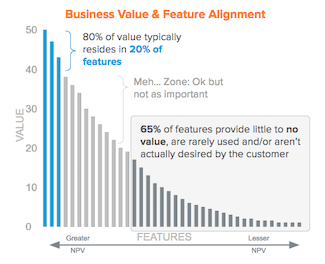There is a revolution happening today. Our 4th! The 4th Industrial revolution is, through technology advancement, driving a more connected world, faster and faster. Will.i.am brought this to life when speaking to Arianna Huffington on Thrive.com's podcast:
"We used to consume news sitting on a couch now we're consuming information at the speeds of space travel, there's no absorbing. There's so much information being thrown around that it's hard to keep up to know what's real and what's fake."
Incredible things are being enabled but there are also tough consequences, such as uncertainty about the future of jobs, skills, and the impact of technology on our lives. In the pace of change across all industries today, it is impossible for companies to survive and thrive without prioritising impact, being nimble and responsive to market conditions, and ruthlessly focusing on customer success.
What is the impact of Agile?
How do organisations need to transform within the environment of this volume and speed of change? Increasing agility enhances the ability to:
- adapt and learn as new challenges come forward and new information becomes available.
- focus on the critical things to deliver to customers today, add value to customer experiences, and not to get drawn by a list of features too long to deliver before things have changed again.
- adapt and respond, to be resilient, to focus on outcomes not outputs.
Where have we seen this?
My teams and I have been fortunate enough to work with some amazing organisations embracing agility (see Thomson Reuters at Dreamforce example) including our own company Salesforce.
For Salesforce agility matters, not because we work through list of features faster or because we “fail” less, but because it's a critical mindset to help us focus on human-centered design, relentless learning, responding to change, and delivering the right outcomes that our customers need to grow their businesses. And through our customers' growth we in turn thrive and have sustainable, predictable, market recognised impact.
The leaders in these companies take their responsibility for spending the company’s investments wisely. For investing to grow, they embrace key agile principles, especially:

- a highest priority to satisfy customers through early and continuous delivery of value
- that simplicity is essential and the real art of a successful lean organisation is that of maximising the amount of work not done! - *80% of value typically resides in 20% of features
Accelerating value using Agile
McKinsey in their paper on why agility pays calls agile organisations those that are able to combine speed and stability. These agile organisations have better organisational health scores and attract far higher premiums. One quote from this work makes the reason for agility in todays world very clear:
“No one would expect sluggish companies to thrive. It’s equally reasonable to assume that success achieved through breakneck speed, without stabilizing processes and structures underfoot, will be hard to sustain over the long term.”
And behind the money metrics, as summarised in the Annual State of Agile Survey 2018, agility brings a:
- 71% increase in ability to manage changing priorities
- 66% improved project visibility
- 65% improvement in business & IT alignment
- 62% increase in time to market
- 61% increased team productivity
In our experience organisations that embrace agility are different, and buck the trends we see where nine out of 10 digital transformations fail to meet business needs, most often due to their organisation's inability to nimbly respond to new conditions. These organisations are different in four specific ways:
- Customer Obsession: The customer is at the center. Everyone and everything is obsessively focused on delivering value, meaningful experiences and a better future to their customers.
- Accelerated Execution: Technologies and structures enable the speed, agility, and innovation to rapidly change direction and bring new offerings to customers.
- High-Performance Teams: People work together in high-trust, accountable, open and collaborative ways to create customer value and the achieve a collective purpose.
- Connected Value: Create continuous value streams and networks for all stakeholders including customers, employees, partners, vendors, communities, and shareholders.
Download our ebook 'How Caesars Entertainment Empowers Teams to Deliver More Personal Customer Experiences' to see how Caesars has increased collaboration between teams and sped up their release cycle which has helped deliver value to guests faster to exceed customer expectations.
Check out our blog post Bring Business and IT Together to Accelerate your Digital Transformation to learn about how to align your critical organisations to speed up success.







